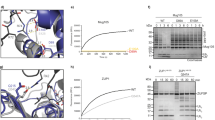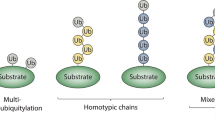Abstract
UBIQUITIN (originally ‘ubiquitous immunopoietic polypeptide’ or ‘UBIP’)1 induces lymphocyte differentiation and was first found in bovine thymus during isolation of the thymic polypeptide hormone thymopoietin (originally ‘thymin’)2 which induces T-cell differentiation3 and has secondary effects on neuromuscular transmission2. Ubiquitin, which has a molecular weight of 8,451, is interesting for several reasons. First, it induces differentiation of T cells and, unlike thymopoietin, B cells1. Second, both properties are inhibited by the β-adrenergic blocking agent propranolol, and so the capacity of ubiquitin to induce lymphocyte differentiation seems to depend on reaction with a β-adrenergic receptor. Third, ubiquitin activates adenyl cyclase in lymphocyte precursors and in other tissues, again through a, β-adrenergic receptor (M. Bitensky, and G. G., unpublished). Finally, ubiquitin, as the name implies, is found not only in thymus but in all other animal cells and in yeasts, bacteria and higher plants1. Although its physiological function remains unknown, ubiquitin must be vital to the living cell to have been conserved over such a long evolutionary time span. We have reported the complete primary structure of bovine ubiquitin4—a single polypeptide chain of 74 amino acids—and now report that human ubiquitin has an identical sequence.
This is a preview of subscription content, access via your institution
Access options
Subscribe to this journal
Receive 51 print issues and online access
$199.00 per year
only $3.90 per issue
Buy this article
- Purchase on Springer Link
- Instant access to full article PDF
Prices may be subject to local taxes which are calculated during checkout
Similar content being viewed by others
References
Goldstein, G., et al., Proc. natn. Acad. Sci. U.S.A., 72, 11 (1975).
Goldstein, G., Nature, 247, 11 (1974).
Basch, R. S., and Goldstein, G., Proc. natn. Acad. Sci. U.S.A., 71, 1474 (1974).
Schlesinger, D. H., Goldstein, G., and Niall, H. D., Biochemistry (in the press).
Dayhoff, M. O. (ed.), Atlas of protein sequence and structure (National Biomedical Research Foundation, Washington, DC, 1972).
Delange, R. J., Fambrough, D. M., Smith, E. K., and Bonner, J., J. biol. Chem., 244, 5669 (1969).
Author information
Authors and Affiliations
Rights and permissions
About this article
Cite this article
SCHLESINGER, D., GOLDSTEIN, G. Molecular conservation of 74 amino acid sequence of ubiquitin between cattle and man. Nature 255, 423–424 (1975). https://doi.org/10.1038/255423a0
Received:
Issue Date:
DOI: https://doi.org/10.1038/255423a0
This article is cited by
-
Yeast polyubiquitin unit regulates synaptonemal complex formation and recombination during meiosis
Journal of Microbiology (2022)
-
Evolution of Conformation and Dynamics of Solvents in Hydration Shell along the Urea-induced Unfolding of Ubiquitin
Chinese Journal of Polymer Science (2019)
-
Regulation of androgen receptor signaling by ubiquitination during folliculogenesis and its possible dysregulation in polycystic ovarian syndrome
Scientific Reports (2017)
-
ISG15: leading a double life as a secreted molecule
Experimental & Molecular Medicine (2013)
-
Quantitative proteomics to decipher ubiquitin signaling
Amino Acids (2012)
Comments
By submitting a comment you agree to abide by our Terms and Community Guidelines. If you find something abusive or that does not comply with our terms or guidelines please flag it as inappropriate.



